“Forged Realities ——假的!”展主题阐释
发起人:东方四绝 回复数:0
浏览数:2443
最后更新:2007/05/11 02:57:59 by
“Forged Realities ——假的!”展主题阐释
姚嘉善 雅昌艺术网专稿 2007-05-08 15:58:04
真实或是虚假意味着什么呢?我们要如何在当代艺术中定义他们呢?区别虚假和真实,真理与谎言,现实与幻想,艺术和生活成为了我们日常现实生活的一部分,在艺术的语境中,关于虚假、伪造和复制受到了极深的哲学关照。
格言“虚假统治着世界”假设了“假的”历史决定性相反面的存在:也就是说曾经有过一时间段,所有的东西都是真实的。当所有定义“真实”的努力变得日益难以捉摸和主观时,我们用“虚假”来暗示事情的真实性。我们的生活正被那些日益增长的东西所控制着,如假冒伪劣商品,盗版,黑市,人文风景的模拟(如北京的世界公园,深圳的世界之窗以及一些著名的风景点),以及经验和环境的复制,我们已经习惯了这种模棱两可,真假难变的生活环境——“假文化”盖过了真文化的势头,而真实的稳定性也不断地被破坏进而变得越来越随性。经济领域的“灰色地带”就是最好的证明,即那些复制品,盗版,水货的大量存在,这现象也同样延伸到了对当代艺术和文化真实性的理解中。
展览“假的!”带给我们来自美国、中国和欧洲共10位艺术家对于艺术、文化及其体现机制等各层面,对于真实性、原创性、复制以及生产置疑和探讨。此展览检视了艺术家将虚假和复制呈现于他们艺术实践和艺术语言的方式,这些反映了我们文化中,被过度强调及夸张了的对于“真实与虚假”的析辨。Kaz Oshiro和Stephanie Syjuco的雕塑作品通过用一些明显有手工制作痕迹的作品和看似机械制作的手工作品来表达作者对于难以分辨真假的视觉挑战。高士强和Jonathan Monk的作品分别通过电影手法,重复叙述横跨不同文化,引人深思的时代错误; 而Patty Chang的ShangriLa则展现了她在去往一个神奇地方的生理历程。倪海丰的作品展现中国过去和现在,在国际上独特复制和艺术生产,而邱志杰的摄影作品展现了国内对不同著名的建筑的复制。艾未未的作品以及洪浩和颜磊的合作作品意在揭露十年来艺术圈的权利厉害关系,如今人们已经不再复制和盗用古老著名艺术品的形式,而开始复制普遍存在的销路好的艺术品。
What does it mean to call something authentic or fake? And how should we consider these terms in relation to contemporary art? Distinguishing between fake and real, truth and fiction, fact and fantasy is part of our negotiation with everyday reality and yet, within the context of art, issues concerning fakes, forgeries and copies pose profound philosophical concerns. One can cite the presence of “fakes and copies” throughout recent contemporary art both in China, from Xu Bing and Gu Wenda’s “fake” Chinese characters to Ai Weiwei’s experiments to Qiu Zhijie’s tireless One Thousand Copies of the Orchid Pavilion; and internationally, from Sherrie Levine, Elaine Sturtevant and Jeff Koons to current examples Jeff Wall and Jeremy Deller.
The dictum “falseness rules the world,” assumes the existence of its historically determined opposite: that there was a time when all was true and real. Similarly, to use the term ‘fake’ implies the very existence of something genuine or real when all efforts to define this realness are progressively more elusive and subjective. With our surroundings increasingly dominated by the presence of fake products, piracy, black markets, fake representations of culture (i.e. Beijing World Park, Shenzhen’s OCT and most major tourist sites), and simulated experiences and environments, we have become accustomed to zones of ambiguity where ‘fake culture’ outstrips the real, and questions of authenticity are routinely destabilized and made arbitrary. Such ‘grey zones’ are most evident in the economic sector, where issues of copyright, piracy and counterfeits abound, but extend also into realms of contemporary art and current understandings of cultural authenticity.
Forged Realities is an exhibition that brings together ten artists from America, China and Europe to probe questions of authenticity, authorship, copying and production as these intersect with art, culture and mechanisms of cultural representation.The exhibition examines the ways in which artists reference fakes and copying in their practice and implement strategies of reproduction and fakery in light of this critical point in our culture where the attribution of ‘original or fake’ carries overblown and at times arbitrary significance. Sculptures by Kaz Oshiro and Stephanie Syjuco are designed challenge the autonomy of the indistinguishable while juxtaposing the handmade with the blandness of pre-fabricated furniture. Retelling existing narratives through film across different cultures or strategies of with deliberate anachronism are part of the work of Gao Shiqiang, Jonathan Monk; while Patty Chang’s Shangri-La undertakes and documents her physical journey to a mythical place. Referencing China’s unique global relationship with regard to copying and art production, past and present, is Ni Haifeng, whereas Qiu Zhijie’s photographs looks at the ways in which self-conscious borrowing of iconic forms manifests itself on a more localized level. Works by Ai Weiwei and a collaborative piece Hong Hao & Yan Lei lay bare the underlying assumptions and power dynamics within the artworld ten years ago and form the basis for more recent experiments which, instead of copying or appropriating a specific style of artwork, now copy the ubiquitous features of the contemporary art industry.
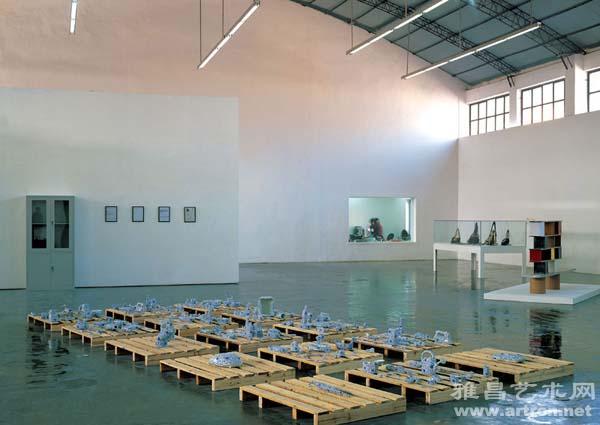
(展览现场图片)
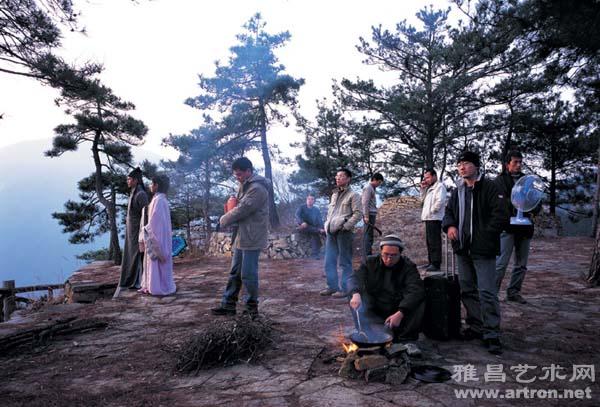
(高世强《十八相送》 录像 2007)
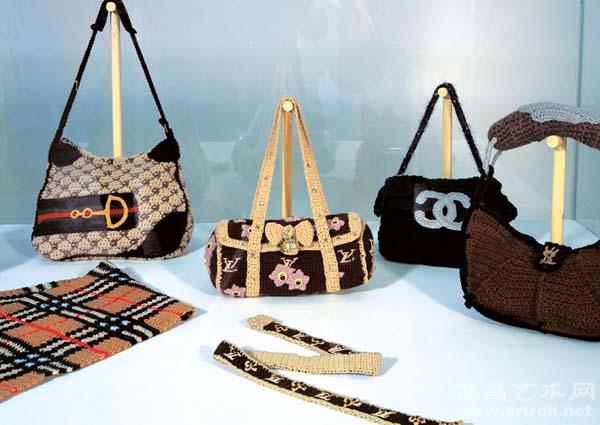
(Stephanie Syjuco 《假的钩花针织袋计划:政治经济批判》 纱线与多媒体)
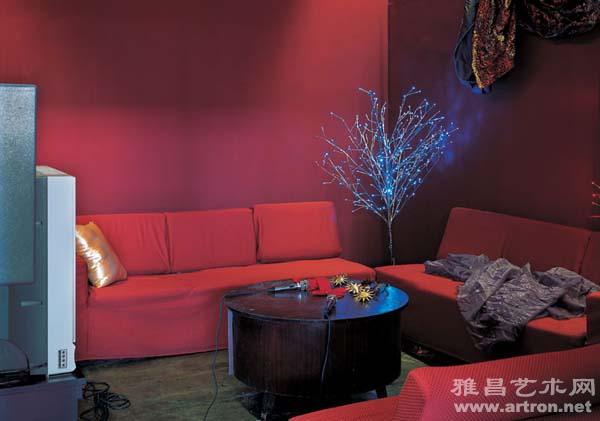
C & C Karaoke Factory 《悬丝卡拉》 录像装置 2004-2007
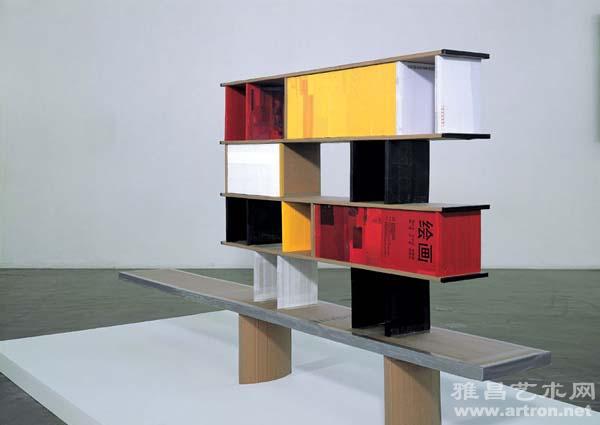
Stephanie Syjuco《五天实现新现代主义仿》 再生纸箱,杂志,胶带 240 x 120 x 50cm 2007
姚嘉善 雅昌艺术网专稿 2007-05-08 15:58:04
真实或是虚假意味着什么呢?我们要如何在当代艺术中定义他们呢?区别虚假和真实,真理与谎言,现实与幻想,艺术和生活成为了我们日常现实生活的一部分,在艺术的语境中,关于虚假、伪造和复制受到了极深的哲学关照。
格言“虚假统治着世界”假设了“假的”历史决定性相反面的存在:也就是说曾经有过一时间段,所有的东西都是真实的。当所有定义“真实”的努力变得日益难以捉摸和主观时,我们用“虚假”来暗示事情的真实性。我们的生活正被那些日益增长的东西所控制着,如假冒伪劣商品,盗版,黑市,人文风景的模拟(如北京的世界公园,深圳的世界之窗以及一些著名的风景点),以及经验和环境的复制,我们已经习惯了这种模棱两可,真假难变的生活环境——“假文化”盖过了真文化的势头,而真实的稳定性也不断地被破坏进而变得越来越随性。经济领域的“灰色地带”就是最好的证明,即那些复制品,盗版,水货的大量存在,这现象也同样延伸到了对当代艺术和文化真实性的理解中。
展览“假的!”带给我们来自美国、中国和欧洲共10位艺术家对于艺术、文化及其体现机制等各层面,对于真实性、原创性、复制以及生产置疑和探讨。此展览检视了艺术家将虚假和复制呈现于他们艺术实践和艺术语言的方式,这些反映了我们文化中,被过度强调及夸张了的对于“真实与虚假”的析辨。Kaz Oshiro和Stephanie Syjuco的雕塑作品通过用一些明显有手工制作痕迹的作品和看似机械制作的手工作品来表达作者对于难以分辨真假的视觉挑战。高士强和Jonathan Monk的作品分别通过电影手法,重复叙述横跨不同文化,引人深思的时代错误; 而Patty Chang的ShangriLa则展现了她在去往一个神奇地方的生理历程。倪海丰的作品展现中国过去和现在,在国际上独特复制和艺术生产,而邱志杰的摄影作品展现了国内对不同著名的建筑的复制。艾未未的作品以及洪浩和颜磊的合作作品意在揭露十年来艺术圈的权利厉害关系,如今人们已经不再复制和盗用古老著名艺术品的形式,而开始复制普遍存在的销路好的艺术品。
What does it mean to call something authentic or fake? And how should we consider these terms in relation to contemporary art? Distinguishing between fake and real, truth and fiction, fact and fantasy is part of our negotiation with everyday reality and yet, within the context of art, issues concerning fakes, forgeries and copies pose profound philosophical concerns. One can cite the presence of “fakes and copies” throughout recent contemporary art both in China, from Xu Bing and Gu Wenda’s “fake” Chinese characters to Ai Weiwei’s experiments to Qiu Zhijie’s tireless One Thousand Copies of the Orchid Pavilion; and internationally, from Sherrie Levine, Elaine Sturtevant and Jeff Koons to current examples Jeff Wall and Jeremy Deller.
The dictum “falseness rules the world,” assumes the existence of its historically determined opposite: that there was a time when all was true and real. Similarly, to use the term ‘fake’ implies the very existence of something genuine or real when all efforts to define this realness are progressively more elusive and subjective. With our surroundings increasingly dominated by the presence of fake products, piracy, black markets, fake representations of culture (i.e. Beijing World Park, Shenzhen’s OCT and most major tourist sites), and simulated experiences and environments, we have become accustomed to zones of ambiguity where ‘fake culture’ outstrips the real, and questions of authenticity are routinely destabilized and made arbitrary. Such ‘grey zones’ are most evident in the economic sector, where issues of copyright, piracy and counterfeits abound, but extend also into realms of contemporary art and current understandings of cultural authenticity.
Forged Realities is an exhibition that brings together ten artists from America, China and Europe to probe questions of authenticity, authorship, copying and production as these intersect with art, culture and mechanisms of cultural representation.The exhibition examines the ways in which artists reference fakes and copying in their practice and implement strategies of reproduction and fakery in light of this critical point in our culture where the attribution of ‘original or fake’ carries overblown and at times arbitrary significance. Sculptures by Kaz Oshiro and Stephanie Syjuco are designed challenge the autonomy of the indistinguishable while juxtaposing the handmade with the blandness of pre-fabricated furniture. Retelling existing narratives through film across different cultures or strategies of with deliberate anachronism are part of the work of Gao Shiqiang, Jonathan Monk; while Patty Chang’s Shangri-La undertakes and documents her physical journey to a mythical place. Referencing China’s unique global relationship with regard to copying and art production, past and present, is Ni Haifeng, whereas Qiu Zhijie’s photographs looks at the ways in which self-conscious borrowing of iconic forms manifests itself on a more localized level. Works by Ai Weiwei and a collaborative piece Hong Hao & Yan Lei lay bare the underlying assumptions and power dynamics within the artworld ten years ago and form the basis for more recent experiments which, instead of copying or appropriating a specific style of artwork, now copy the ubiquitous features of the contemporary art industry.

(展览现场图片)

(高世强《十八相送》 录像 2007)

(Stephanie Syjuco 《假的钩花针织袋计划:政治经济批判》 纱线与多媒体)

C & C Karaoke Factory 《悬丝卡拉》 录像装置 2004-2007

Stephanie Syjuco《五天实现新现代主义仿》 再生纸箱,杂志,胶带 240 x 120 x 50cm 2007